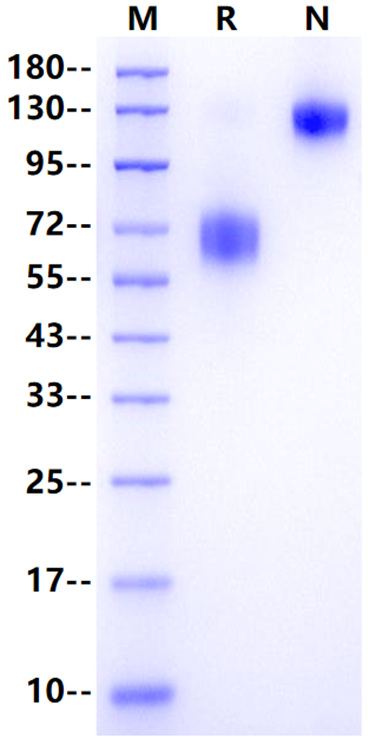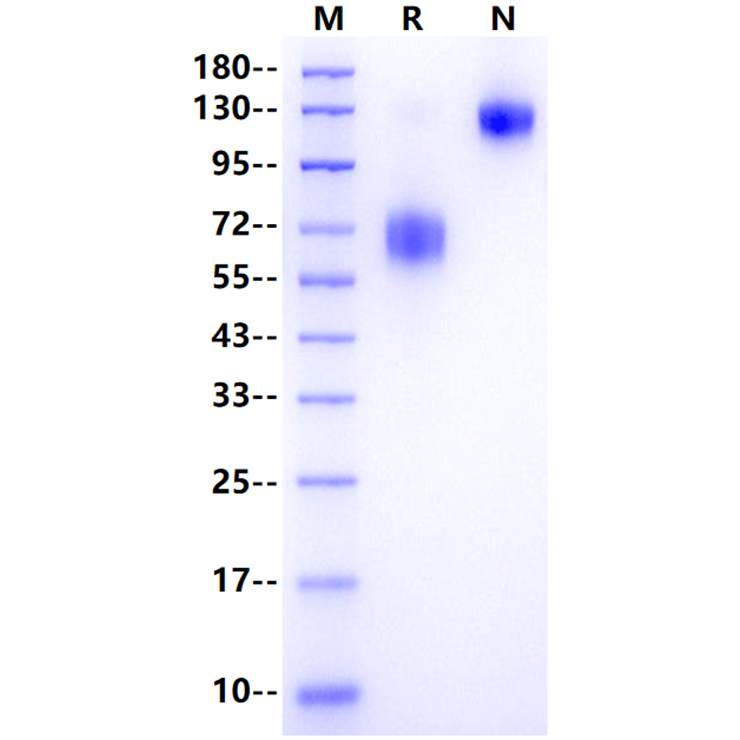1μg (R: reducing condition, N: non-reducing
condition).
Product Details
Product Details
Product Specification
| Species | Mouse |
| Synonyms | FCE1A, FcERI, Fc epsilon RI α |
| Accession | P20489-1 |
| Amino Acid Sequence | Ala24-Gln204, with C-hFc |
| Expression System | HEK293 |
| Molecular Weight | 60-80kDa (Reducing) |
| Purity | >95% by SDS-PAGE & SEC-HPLC |
| Endotoxin | <0.1EU/μg |
| Conjugation | Unconjugated |
| Tag | Human Fc Tag |
| Physical Appearance | Lyophilized Powder |
| Storage Buffer | PBS, pH7.4. |
| Reconstitution | Reconstitute at 0.1-1 mg/ml according to the size in ultrapure water after rapid centrifugation. |
| Stability & Storage | · 12 months from date of receipt, lyophilized powder stored at -20 to -80℃. · 3 months, -20 to -80℃ under sterile conditions after reconstitution. · 1 week, 2 to 8℃ under sterile conditions after reconstitution. · Please avoid repeated freeze-thaw cycles. |
| Reference | 1. Shimizu,
A. et al. (1988) Proc. Natl.
Acad. Sci. USA 85:1907. |
Background
Fc epsilon RI α, also known as FCER1A, is the α
subunit of immunoglobulin receptor (IgE receptor). IgE receptor consists of one
α subunit, one β subunit and two γ subunits. The α subunit includes
extracellular domain and transmembrane domain, and the extracellular region
contains two immunoglobulin-like domains, in which the proximal membrane end is
the binding region to IgE Fc, and the other end is related to high affinity.
The α subunit contains seven N-chain glycosylation sites, which can guide the
correct folding of the α-chain. β subunit is divided into transmembrane region
and intracellular region, which is a four-time transmembrane molecule with
immune receptor tyrosine activation motif (ITAM). The γ subunits are connected
by disulfide bonds and each has a transmembrane region. Fc epsilon RI α first
initiates anaphylaxis. Allergens act on mast cells through IgE and Fc epsilon
RI α, activate chemical mast cells through signal transduction, release
vasoactive mediators such as histamine and bradykinin to cause
hypersensitivity, or pre-release Leucotrienes, leukotrienes and platelet
activating factors to cause inflammation.
Picture
Picture
SDS-PAGE



